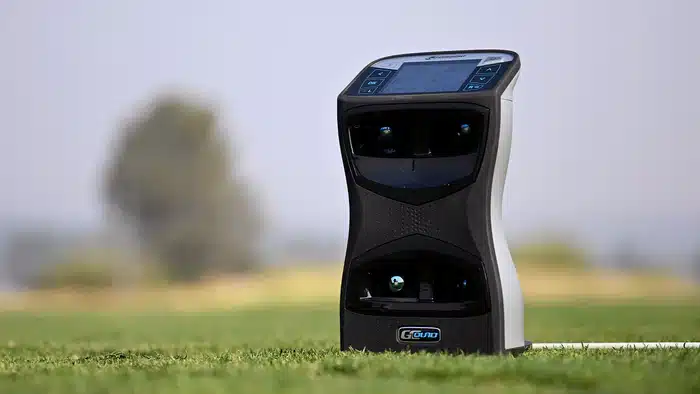Tour pros overwhelmingly favor GCQuad over TrackMan for indoor practice, with 70% choosing Foresight's camera-based system. You'll find GCQuad's quadrascopic vision delivers superior spin accuracy, showing a standard deviation of just 82 compared to TrackMan's 175. GCQuad's plug-and-play setup works in smaller spaces without subscriptions, while TrackMan requires 6-8 feet behind you plus $5,500 in software costs over five years. Continue exploring to uncover the complete breakdown of features, pricing, and performance differences.
Unlock your full golfing potential with the TrackMan launch monitor, the gold standard in precision technology, trusted by top pros for game-changing insights.
When you're choosing between the GCQuad and TrackMan, you're really picking between two completely different approaches to measuring your golf swing. TrackMan uses dual-radar technology, shooting signals behind the ball at roughly 40,000 frames per second to track everything during flight. It's like having invisible eyes watching your ball's entire passage through the air.
GCQuad takes a completely different approach with four ultra-high-speed cameras capturing around 10,000 frames per second from multiple angles. Think of it as having four photographers snapping snapshots of your impact zone! Here's the key difference: TrackMan calculates spin from flight data, while GCQuad actually sees the ball rotating. The GCQuad measures data at impact using its ultra-high-speed cameras to capture what happens at the moment of contact. Camera-based systems like the GCQuad excel at spin measurement accuracy compared to radar-only systems, providing direct visual tracking rather than estimates. The GCQuad combines this camera system with some radar functions, making it a true hybrid.
Both devices are designed for indoor and outdoor usability, though their performance characteristics can vary depending on your setup environment. The GCQuad combines this camera system with some radar functions, making it a true hybrid.

Now that you understand how these systems work, let's plunge into what really matters: which one gives you more accurate and consistent data.
This is where GCQuad really shines. In robot testing, GCQuad's spin axis measurements showed a standard deviation of just 82, while TrackMan hit 175, which is more than double the variation! This consistency becomes essential when you're hitting off-center strikes, which happens more often than you'd like to admit.
GCQuad's four-camera system captures 200 images at impact, giving you millimeter-accurate data. TrackMan's dual radar runs at 40,000 frames per second, which sounds impressive, but the point is: GCQuad's direct measurement approach produces less scatter across repeated shots under identical conditions, making your data more reliable. The GCQuad's quadrascopic vision technology delivers significantly lower standard deviations on mis-hits, ensuring professional-grade consistency that club fitters and PGA Tour players rely on daily.
When tested simultaneously in identical outdoor environments using the same equipment, GCQuad demonstrated 99.9% accuracy in data measurement compared to TrackMan's lower consistency ratings.
While data accuracy gets most of the attention, your choice between GCQuad and TrackMan often comes down to something much more practical: how easy they are to set up and use.
Here's the thing: GCQuad wins the convenience battle hands down. You'll simply place it near the ball, connect to your tablet, and start swinging. It's genuinely plug-and-play, processing everything on the device itself with bundled software that doesn't need subscriptions. The Launch Monitor operates independently without requiring computer processing for data capture and reading.
TrackMan's a different beast entirely. You'll need 6-8 feet behind the ball, precise positioning, and external devices for data processing. Plus, you're looking at subscription costs for simulation software. For optimal performance, you'll need a computer with at least 32GB of RAM to handle the software processing demands.
If you're working with smaller rooms under 15 feet, GCQuad's your only realistic option. TrackMan demands serious space commitment!

Setup preferences matter, but nothing validates a launch monitor's credibility quite like seeing it in the hands of Tour professionals week after week. You'll spot GCQuad units dominating PGA Tour practice ranges, where pros rely on its Quadrascopic imaging technology, capturing 200 images at impact for millimeter-accurate data. The key point, while Trackman's popular too, GCQuad's often the preferred choice for indoor use due to space constraints. Tour pros consistently choose GCQuad for both practice sessions and club fitting because its photometric system delivers more detailed club data than Trackman's radar technology. Notably, tour professionals actually purchase Foresight products rather than receiving them as endorsements, indicating a genuine preference for the system's reliability. The extensive metrics, launch angle, spin rates, club path, and impact location give pros the precise feedback they need for elite-level performance optimization. This precision is enabled by the GCQuad's four high-speed cameras that provide stereoscopic vision, measuring objects from two angles for enhanced accuracy in data capture.
Beyond the tech specs and performance metrics, your wallet will ultimately determine which launch monitor makes sense for your situation. The GCQuad costs $17,999 upfront, while the Trackman 4 hits $21,995 plus a mandatory $1,100 annual subscription. The key point, that subscription adds up fast! Over five years, you'll pay an extra $5,500 just for software access.
Foresight takes a different approach. You get full software access for life, plus 25 golf simulation courses included. No hidden fees, no surprise charges. Trackman's subscription does release 300+ courses, but those ongoing costs make budget planning tricky.
The GC3 at $6,999 offers serious value without subscriptions. For long-term ownership, Foresight's straightforward pricing eliminates the guesswork and keeps your investment predictable. With professional launch monitors showing a typical 3-5 year lifespan before replacement, eliminating recurring subscription costs significantly improves your total return on investment.
Pricing gets you in the door, but the software and data capabilities determine whether you'll love or regret your launch monitor choice. Here's where these titans separate dramatically.
GCQuad's touchscreen interface keeps things simple; you get immediate data access without juggling tablets or phones. It's truly plug-and-play, making setup effortless for busy coaches. TrackMan requires external devices, adding complexity but revealing powerful ecosystems like TrackMan Combine and Test Center 2.0.
The measurement methods tell different stories. GCQuad captures 10,000 frames per second using quadroscopic cameras, providing tighter spin rate consistency (82 RPM standard deviation versus TrackMan's 175 RPM). TrackMan's dual-radar system shoots 40,000 frames per second but needs spotting space and ambient conditions. While GCQuad's integrated barometric sensors maintain accuracy regardless of altitude or humidity, TrackMan compensates with its ability to track over 40 parameters, including club speed, face angle, and attack angle for comprehensive swing analysis!
Discover why the Foresight GCQuad launch monitor is the ultimate choice for golfers seeking unmatched precision and detailed shot analysis. From accurate ball tracking to advanced club data, this device elevates practice and play to a pro level. Dive into our expert review and see how it can transform your game.
No, you can't leave reflective dots on your clubs during tournament play. The USGA strictly prohibits any clubface attachments during competition, even tiny 3-4mm stickers that seem harmless. The point is, you must remove all launch monitor dots before your round starts. If you forget, you can remove them before hitting, but playing with them attached means disqualification. Just ask Rory Sabbatini!
Weather hammers outdoor accuracy for both systems, but differently. You'll see TrackMan's radar struggle more with rain and wind since it tracks ball flight, while GCQuad's cameras hate changing sunlight and shadows. Indoors, you're golden! Controlled lighting makes GCQuad super consistent, and TrackMan doesn't fight wind interference. Temperature and humidity stay stable indoors, too, giving you repeatable measurements every time.
You'll want the GCQuad for learning swing fundamentals. It delivers more consistent data on key metrics like spin axis, especially on off-center hits that beginners make frequently. The immediate feedback on its built-in screen means you're not fumbling with multiple devices. Plus, it's $3,500 cheaper than TrackMan 4 and works perfectly indoors, where you'll spend most practice time perfecting basics.
Both systems work well on driving ranges, but they've got different strengths. GCQuad's cameras excel in tight range bays and give you instant feedback on your swing mechanics. Trackman's radar needs more space to track full ball flight, but delivers remarkable distance data outdoors. The key point is: GCQuad wins for indoor ranges, while Trackman shines on outdoor ranges with plenty of room!
You'll find the GCQuad needs minimal calibration since its camera technology stays stable over time. Your main focus should be on monthly battery discharge cycles to prevent expensive replacements. TrackMan requires daily calibration routines before sessions, plus regular sensor cleaning and environmental adjustments. The key point is, GCQuad's maintenance centers on battery care, while TrackMan demands consistent calibration protocols to maintain accuracy.
You don't need to pick sides in this launch monitor battle. Both Uneekor and Foresight deliver solid performance, just through different approaches. If you're budget-conscious and love visual feedback, Uneekor's overhead camera system gives you excellent bang for your buck. Want the most precise data money can buy? Foresight's optical sensors won't disappoint. Consider your priorities, test both if possible, and choose what fits your game best.